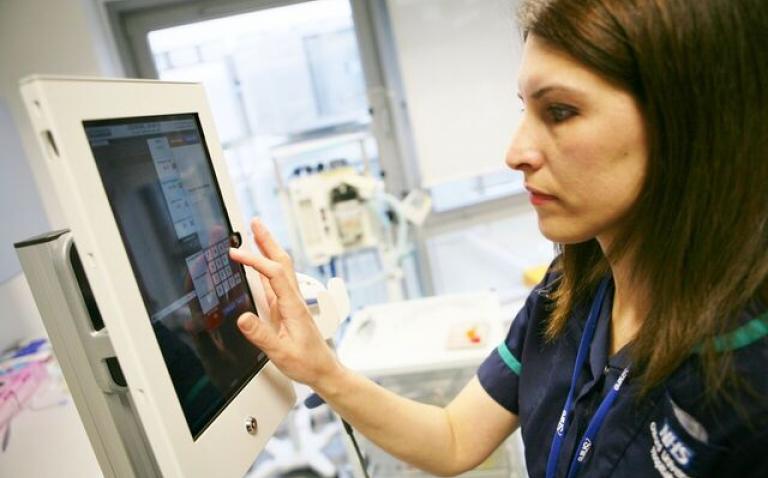The System for Electronic Notification and Documentation (SEND) was developed by the University of Oxford for recording patient vital signs.
A study of three wards at the Churchill and Horton hospitals found the typical time to record the vital signs on a paper chart – traditionally hung at the end of beds – was 215 seconds, or three minutes and 35 seconds. The typical time to record to input the vital signs into SEND was 150 seconds, or two minutes and 30 seconds.
The study, reported in the Journal of the American Medical Informatics Association, is the biggest yet of the impact of the system, introduced from 2014 and now fully rolled out at Oxford University Hospitals NHS Foundation Trust hospitals.
The previous paper-based ‘track and trigger’ system involved staff documenting vital signs on paper charts and manually working out the state of the patient’s condition. SEND works through staff inputting a patient’s vital signs such as heart rate and blood pressure. The tablet – which links to patients’ barcoded wristbands to identify them – immediately provides advice on how to manage the patient’s care and clearly displays any deterioration in their condition.
It also means information about patients can be shared around the Trust, including on desktop computers, saving crucial time that was previously spent looking for and transporting paper charts.
As SEND provides immediate advice based on the vital signs inputted, the system eliminates errors from manually calculating patient risk scores as well as errors from the omission of key data, illegible handwriting and misinterpretation of paper notes. Observations are also stored in the patient’s electronic medical records, called the Electronic Patient Record (EPR). Each ward has about six tablet computers.
The study involved recording time taken to record vital signs for two, five-week periods, one for the paper system and one with SEND, comprising a total of 606 observation sets. and concluded that the time saved was statistically significant and that systems like SEND can be faster than paper charts.
It noted that the time saved varied by ward. Understanding which sort of wards would benefit the most will require further research.
Paper co-author David Wong said: “This paper’s finding supports the message that we have been hearing from front-line staff, that SEND facilitates fast and accurate recording of patient vital signs.SEND frees up more time for clinical care, which we believe will ultimately lead to better outcomes for patients.”
The technology has been devised and researched through the NIHR Oxford Biomedical Research Centre, a collaboration between the Trust and the University of Oxford to fund medical research. A team of doctors, nurses, ergonomists and engineers from the trust and university created the software and hardware for SEND.
Funding to put the system onto wards has been provided by the Department of Health’s Safer Hospitals, Safer Wards NHS Technology Fund.
The University and the Trust have recently partnered with Drayson Technologies, which will take responsibility for the deployment of SEND under an exclusive license agreement, following wider testing. Drayson Technologies will provide a dedicated development operations team to support further evaluation of SEND and will work with the university and the trusts to manage its wider deployment and commercialisation across the NHS.
The company intends to develop SEND into a central platform in which other digital health applications can inter-operate, allowing for further improvement outcomes for patient health and efficiencies for the NHS.










